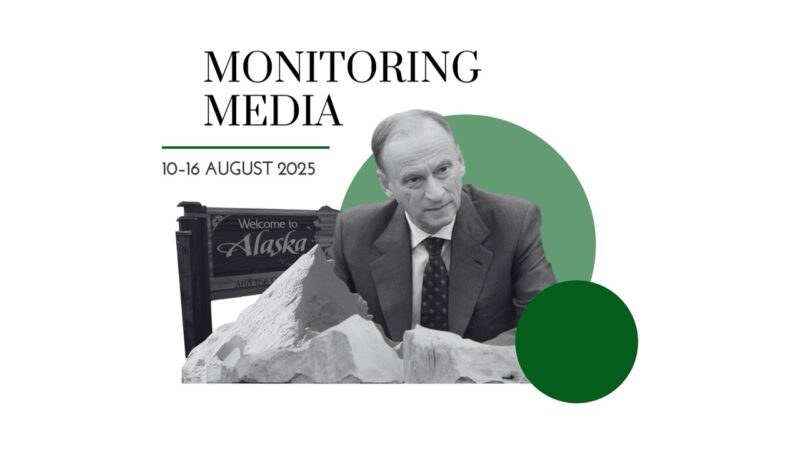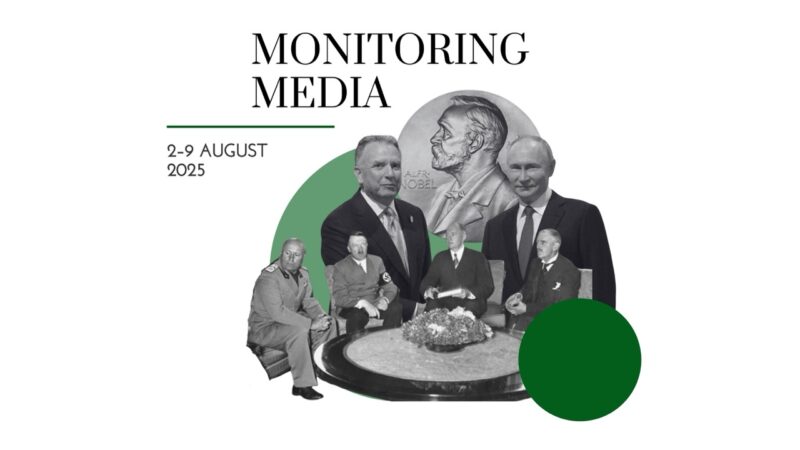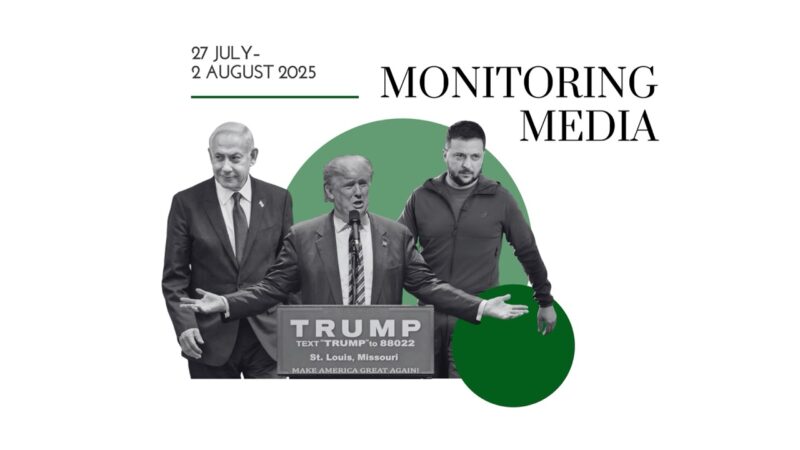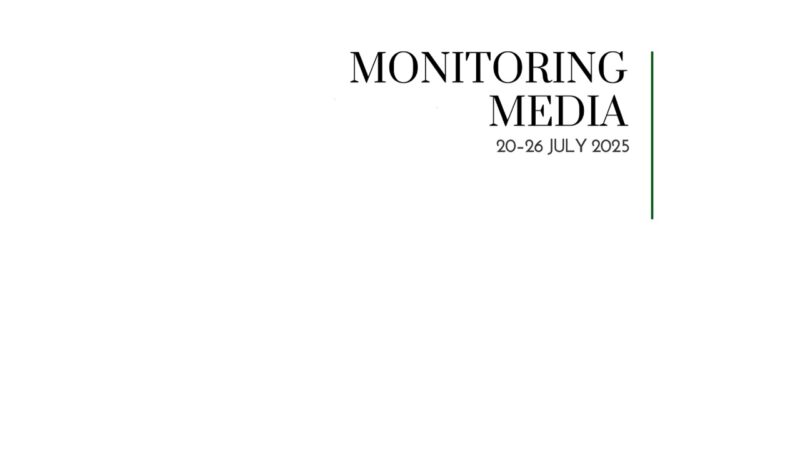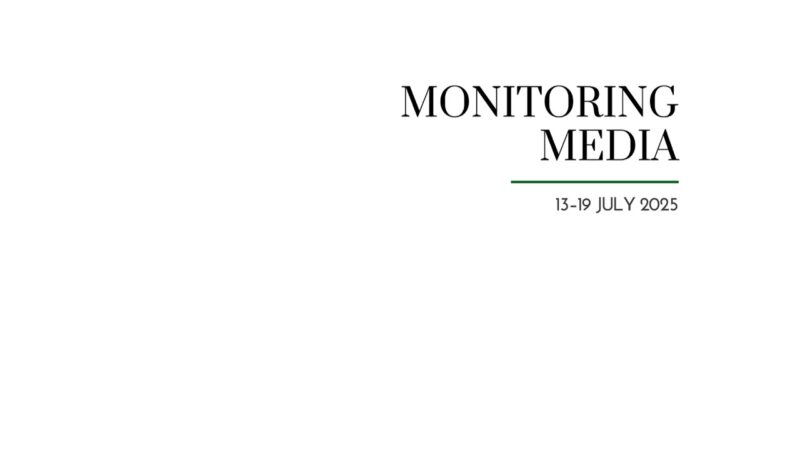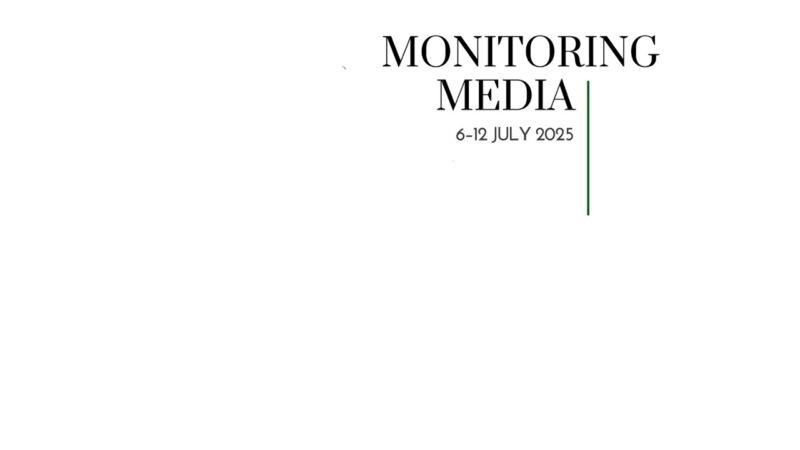Ukraine will receive Abrams and Leopard battle tanks

CIUS weekly report on North American media coverage of Ukrainian affairs, 21–27 January 2023
Three publications (Politico, The Wall Street Journal, and The New York Times) were selected to prepare this report on how the situation in Ukraine has been portrayed in the North American press during the past week (21–27 January 2023). The sample was compiled based on their impact on public opinion as well as on their professional reputation, popularity among the readership, and topical relevance. These three publications represent centrist and liberal viewpoints on the political spectrum.
This report covers only the most-read and relevant articles about Ukraine, as ranked by the respective North American publications themselves in the past week. Its scope covers promoted articles on home pages and articles from special sections on Ukraine, with the hashtag #Ukraine, from the paper editions of the publications, and about Ukraine from opinion columns and editorials.
Topics featured in the selected articles:
- Ukraine’s current affairs: the Ukrainian army is under constant attack but continues to hold its ground in the east and south; the Ukrainian army needs more weapons for new operations in the spring to be successful;
- The world and Ukraine: the US will be producing more weapons and ammunition to help Ukraine; US and Germany agreed to deliver battle tanks to Ukraine; the US designated the mercenary Wagner Group as a criminal organization; US philanthropists send humanitarian aid to help Ukrainians endure through wartime hardships;
- Russia at war: civic leaders and ordinary Russians need to take action against the Kremlin to put an end to the war; Russia recruits former commandos from Afghanistan to fight in Ukraine.
Main arguments:
Ukrainian army repels Russia in the east but seems to be struggling in the south. In his article, Jared Malsin (Wall Street Journal) delivers detailed news and updates. Firstly, “Ukraine’s military drove back Russian attempts to advance in eight different locations along the front lines in the country’s east, the Ukrainian general staff said [on 25 January].” The town of Bakhmut remains under the control of the Ukrainian army notwithstanding unceasing attempts by Russians to capture it. Secondly, to continue successfully defending the eastern parts of the state, the Ukrainian army needs more and better weapons. As things stand now, Russia still possesses higher firepower, and Ukraine cannot make progress on the ground as it lacks heavy armour for a successful counterattack. Thirdly, the US, British, and German governments agreed to supply Ukraine with their advanced battle tanks in the future, while Turkey has already sent two new Bayraktar TB-2 drones. In response, “Russia has launched wave upon wave of missile strikes targeting Ukraine’s energy infrastructure” on 25 January.
To these messages, Evan Gershkovich and Ian Lovett (Wall Street Journal) add that Russian officials are boasting that their army is advancing in the south of Ukraine, specifically in the Donbas and Zaporizhia oblast, taking “more advantageous lines and positions.” The Ukrainian side denies that Russia has made any considerable advancements recently. However, if the Russian declarations are true, then, according to Gershkovich and Lovett, the “mobilization drive of 300,000 reservists along with the recruitment of inmates from across Russia’s vast prison system into the Wagner paramilitary group” have improved the combat effectiveness of the invading army. If, moreover, the Russian advancements are true, they highlight the urgency for the West to supply tanks and other sophisticated weapons to Ukraine. In their turn, Russian officials claim that “supplies of offensive weapons to Kyiv…would lead to a global catastrophe” because Russia would retaliate “with more powerful weapons.”
Ukraine is successful in liberating Kreminna city but requires more weapons from the West to continue the counterattack. Lara Seligman (Politico) writes that while the front line has remained comparatively stable during the winter months, the Ukrainian army managed to advance in northeastern battlefields and approach the border of occupied Luhansk oblast. In particular, Ukraine secured territory around the strategic city of Kreminna, which “is seen as a gateway to Sievierodonetsk and Lysychansk, two key industrial centers in the Donbas region that Russia seized last summer.” This advancement is regarded as the new step in the ongoing counterattack that Ukraine launched in Kharkiv oblast in September 2022. The gains near Kreminna occur as Russia regroups and prepares for its campaign in the spring: “The Ukrainian military has recently reported seeing increased Russian movement of troops, military equipment, and ammunition in the Luhansk area.” In order to continue advancing, the Ukrainian army requires support from the West, and a number of key countries are evidently willing to provide it. For instance, the weapons that Ukraine will receive from the US in the next few months, on top of what has already been delivered, will suffice to equip “at least two combined arms maneuver brigades or six mechanized infantry battalions, 10 motorized infantry battalions, and four artillery battalions.” Depending on the delivery schedule and quality of related training, Western officials believe that “it is possible for the Ukrainians to run a significant tactical- or even operational-level offensive operation” in the spring.
US increases its capacities for weapons and ammunition production. John Ismay and Eric Lipton (New York Times) write that the Pentagon decided to increase its artillery production sixfold based on the intensity of the utilization of unguided shells in Ukraine. This increase in the levels of ammunition production will lead to the first major modernization of military factories in forty years. It will be the biggest since the Korean War and will also help to build up stockpiles for future needs. Ismay and Lipton argue that the Russo-Ukrainian war has made the US military rethink its vision of military conflicts in the 21st century, because the intensive grinding aspect of the ground war has neither disappeared from the battlefield nor been replaced with more targeted and technological strikes: “Unguided artillery shells have become the cornerstone of the 11-month-old conflict, with both Ukrainian and Russian troops firing thousands of howitzer rounds at each other every day, along a front line more than 600 miles long.” Furthermore, the Pentagon’s decision to increase artillery production serves as indirect proof “that the United States plans to back Ukraine no matter how long the war continues.”
US and Germany announce battle tanks will be delivered to Ukraine. Michael R. Gordon, Gordon Lubold, and Bojan Pancevski (Wall Street Journal) write that “the Biden administration [confirmed that it will] send a significant number of Abrams M1 tanks to Ukraine, settling a rift that threatened the unity of the alliance supporting Ukraine at a pivotal moment in the war.” This move comes as a reaction to the reluctance of the German government to send its Leopard 2 tanks before any of its Western coalition partners sets the precedent. According to the authors, “Mr. Scholz was concerned about ending up with a fleet of almost exclusively German-made tanks being used to fight the Russians in Ukraine, a scenario that could single his country out as a party to the conflict.” That being said, Leopard 2 tanks seem to be the best choice for Ukraine, as there are hundreds of them serving in the European armies, not to mention that supply and maintenance chains are much easier to build around the German tanks compared with their US analogues. In turn, the Ukrainian side has long been emphasizing that Western heavy weaponry—above all battle tanks—is needed to liberate Ukraine’s regions, including Crimea, from Russian occupation, as well as to effectively stand against the recently mobilized hundreds of thousands of Russian soldiers.
In her article, Lara Seligman (Politico) also touches upon the US decision to deliver 31 Abrams M1 main battle tanks, which she interprets as “a significant show of support for Kyiv” and “a huge symbolic win for Ukraine.” Seligman cites President Biden, who believes that Ukrainians need Abrams tanks “to be able to counter Russia’s evolving tactics and strategy on the battlefield in the very near term. They need to improve their ability to maneuver in open terrain, and they need an enduring capability to in turn defend against Russian aggression over the long term.” On the other hand, Pentagon officials consider that delivering Abrams tanks to Ukraine may not necessarily be the right decision: “The Abrams tank is a very complicated piece of equipment. It’s expensive, it’s hard to train on. It has a jet engine, I think it’s about three gallons to the mile of jet fuel. It is not the easiest system to maintain.” Finally, Seligman highlights that it may take months before the first US battle tank arrives in Ukraine. However, once this happens the US will essentially be committed to supporting the Ukrainian armed forces for decades.
US outlaws Russia’s Wagner Group but should adopt even harsher legal actions. Justyna Gudzowska and Nathalia Dukhan (Politico) discuss the fact that on Thursday 26 January the Biden administration designated the Wagner Group—an army of mercenaries from Russia led by Evgenii Prigozhin—as a transnational criminal organization. While this may be a significant step, it is not enough because the Wagner Group resembles more a terrorist organization akin to ISIS than a gang. Gudzowska and Dukhan advocate that it would be appropriate to further change the legal status of the Wagner group and employ the most powerful economic tool Washington possesses for its abolition—namely, a criminal statute that prohibits any business actor affiliated with the US from providing “material support” to the Wagner Group. The authors further explain: “Due to the extra-territorial nature of the statute, a designation [as a terrorist organization] would substantially hamper Wagner’s operations by putting foreign individuals, companies, and countries on notice that doing business with the organization means risking prosecution in the United States.” Several legal and counterterrorism experts have already weighed in that the Wagner Group meets the definition of a terrorist organization. However, Gudzowska and Dukhan argue that the Biden administration is reluctant to take additional legal action, as this will further escalate tensions between Washington and the Kremlin as well as trigger further humanitarian disasters on the territories occupied by Wagner mercenaries. The authors conclude that sooner or later the international community will have to put forward a joint effort to curtail the Wagner Group, which is growing into a transnational threat.
US philanthropists help to increase Ukraine’s grassroots resilience in times of war. Judith Miller (Wall Street Journal) writes that the US private sector became sympathetic to Ukraine’s war effort and started delivering flak jackets, tourniquets, weapons, and heaters. In particular, Miller writes about the activities of the former New York governor George Pataki and his friend Earle Mack, a real-estate developer and former US ambassador to Finland; they sourced 385 industrial-strength heaters and shipped them to Transcarpathia oblast in January 2023. Miller highlights that “while many analysts have focused on the effect of the West’s indispensable military aid to Kyiv, such creative, targeted philanthropy is also essential if Ukraine is to win this war.” This aid and equipment delivered by the US philanthropists are further distributed among “points of invincibility”—public shelters in portable tents or fortified government buildings, where Ukrainians can hide from Russia’s bombardments as well as find electricity, warmth, and comfort. Miller concludes that “given what is at stake in Ukraine for the US and its democratic allies, the money they and others pledge to humanitarian assistance could make the difference.”
Russians need to mobilize against the Kremlin and stop the invasion of Ukraine. In their article, the editorial board of The New York Times argues that “the war in Ukraine has entered a new, more deadly and fateful phase, and the one man who can stop it, Vladimir Putin, has shown no signs that he will do so” and also that “the war is at a stalemate.” Moreover, with all the Western support Ukraine is receiving and with all the armaments that the Russian military complex is producing today, “the broad, muddy fields of Ukraine will soon again witness full-scale tank-and-trench warfare, this time pitting Western arms against a desperate Russia. This was never supposed to happen again in Europe after the last world war.” The board frames its editorial article as being addressed to Russians, because “it is in their name that their president is waging this terrible and useless war; their sons, fathers, and husbands are being killed, maimed, or brutalized into committing atrocities; their lives are being mortgaged for generations to come in a state distrusted and disliked in many parts of the world.” Russians are portrayed as an informationally isolated nation that can obtain opinion-forming information only from the Kremlin’s biased media sources. The NYT encourages Russians to stop perceiving Ukraine as the enemy, as was common before 2014, and to mobilize for the preservation of the economic and political freedoms that Putin stripped from them by authorizing the invasion. Russians need to acknowledge that their country has transformed into an international pariah and that their compatriots in the war have sustained enormous casualties. They should also understand that an escalation of aggression against Ukraine will not lead to the resolution of the war. The editorial board of the NYT draws a line between the Kremlin and ordinary Russians, encouraging the latter to stop being “played for fools by Mr. Putin’s vanity, delusions and spitefulness.”
Russia recruits Afghan soldiers who underwent US military training. Thomas Kasza (New York Times), a former Green Beret soldier who helped indigenous forces to topple the Taliban in 2001, writes that his Afghan comrades are today fighting against Ukraine in Putin’s foreign legion: “Since the precipitous departure [of US forces] from Afghanistan in 2021, and in the absence of meaningful government support to the nonprofit organizations that have worked to aid our former allies, many of those highly trained commandos have accepted recruitment offers to fight with the Russian Army in Ukraine.” Kasza estimates that there may be up to 30,000 Afghan soldiers deployed on battlefields in Ukraine. The major reason for them to join the Russian army is Washington’s political disinterest in supporting Afghan society following the 2021 departure, which left many of its pro-American citizens jobless, persecuted, and with no prospects of relocating to the West. For such people, Putin offers at least some hope for a brighter future: “If they fight for Russia, their families might live under better conditions, they might earn a $1,500 recruitment incentive, and they might earn Russian citizenship. The irony is that those who head to the front lines in the Donbas will be shredded by the very same American-built weapons that once supported them in battle.” For its part, the Taliban supports the recruitment of former Afghan commandos by Russia because “the most dangerous core for a resistance movement is fleeing the country.” As for the US, it is continuing to suffer reputational damage, as it appears to have abandoned its loyalists and allies. In conclusion, Kasza writes that “I’ll look to the healing of my own moral wounds as best as I am able. I hope that Congress in turn can lead and help our nation start healing in its own right by honoring the promises we made to those who went into combat on our behalf.”
